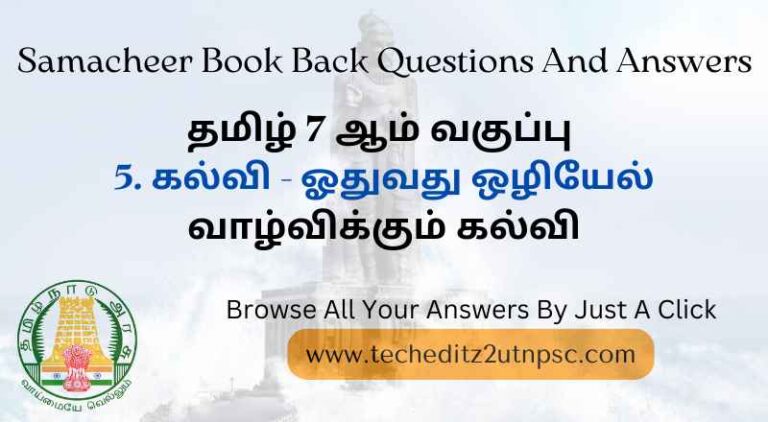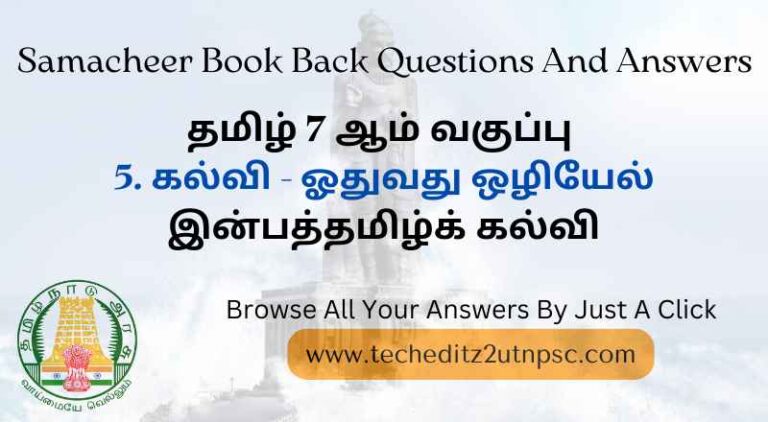support@techeditz2utnpsc.com | 8300-921-521

Transportation in Plants and Circulation in Animals
Samacheer Book Back Questions And Answers For Science Standard 10 “Transportation in Plants and Circulation in Animals“
I. Choose the correct answer:
1. Active transport involves
a) movement of molecules from lower to higher concentration
b) expenditure of energy
c) it is an uphill task
d) all of the above
2. Water which is absorbed by roots is transported to aerial parts of the plant through
a) cortex
b) epidermis
c) phloem
d) xylem
3. During transpiration there is loss of
a) carbon dioxide
b) oxygen
c) water
d) none of the above
4. Root hairs are
a) cortical cell
b) projection of epidermal cell
c) unicellular
d) both b and c
5. Which of the following process requires energy?
a) active transport
b) diffusion
c) osmosis
d) all of them
6. The wall of human heart is made of
a) Endocardium
b) Epicardium
c) Myocardium
d) All of the above
7. Which is the sequence of correct blood flow
a) ventricle – atrium – vein – arteries
b) atrium – ventricle – veins – arteries
c) atrium – ventricle – arteries – vein
d) ventricles – vein – atrium – arteries
8. A patient with blood group O was injured in an accident and has blood loss. Which blood group the doctor should effectively use for transfusion in this condition?
a) O group
b) AB group
c) A or B group
d) all blood group
9. ‘Heart of heart’ is called
a) SA node
b) AV node
c) Purkinje fibres
d) Bundle of His
10. Which one of the following regarding blood composition is correct
a) Plasma – Blood + Lymphocyte
b) Serum – Blood + Fibrinogen
c) Lymph – Plasma + RBC + WBC
d) Blood – Plasma + RBC+ WBC + Platelets
II. Fill in the blanks:
1. _____ involves evaporative loss of water from aerial parts.
2. Water enters the root cell through a _____ plasma membrane.
3. Structures in roots that help to absorb water are _____.
4. Normal blood pressure is _____.
5. The normal human heartbeat rate is about _____ time per minute.
Answers:
1. Transpiration
2. root hair
3. root hair
4. 120/80 m Hg
5. 72
III. Match the following:
Section I
1. Symplastic pathway A. Leaf
2. Transpiration B. Plasmodesmata
3. Osmosis C. Pressure in xylem
4. Root Pressure D. Pressure gradient
Answers:
1. B
2. A
3. D
4. C
Section II
1. Leukemia A. Thrombocytes
2. Platelets B. Phagocyte
3. Monocytes C. Decrease in leucocytes
4. Leucopenia D. Blood Cancer
5. AB blood group E. Allergic condition
6. O blood group F. Inflammation
7. Eosinophil G. Absence of antigen
8. Neutrophils H. Absence of antibody
Answers:
1. D
2. A
3. B
4. C
5. H
6. G
7. E
8. F
IV. State whether True or False. If false write the correct statement
1. The phloem is responsible for the translocation of food.
2. Plants lose water by the process of transpiration.
3. The form of sugar transported through the phloem is glucose.
4. In apoplastic movement the water travels through the cell membrane and enter the cell.
5. When guard cells lose water the stoma opens.
6. Initiation and stimulation of heart beat take place by nerves.
7. All veins carry deoxygenated blood.
8. WBC defend the body from bacterial and viral infections.
9. The closure of the mitral and tricuspid valves at the start of the ventricular systole produces the first sound ‘LUBB’.
Answers:
1. True
2. True
3. False (The form of sugar transported through the phloem is sucrose)
4. False (In apoplastic movement the water travels through the intercellular spaces and walls of the cells)
5. False (When guard cells become turgid the stoma opens)
6. False (Initiation and stimulation of heart beat take place by muscles)
7. False (All veins carry deoxygenated blood except pulmonary vein which carries oxygenated blood)
8. True
9. True
Visit Our YouTube Channel For More Free Videos: Click Here


